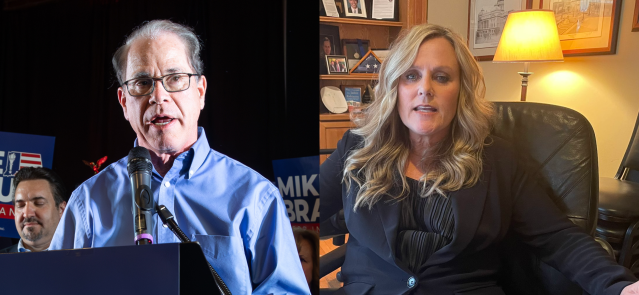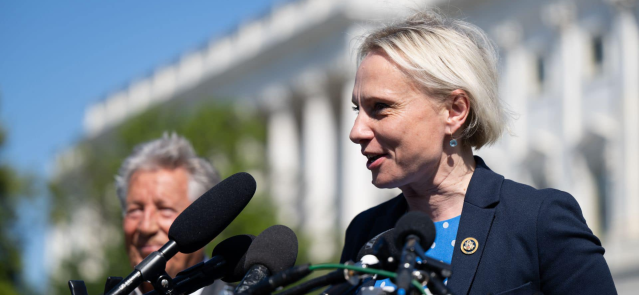Stay ahead of the curve as a political insider with deep policy analysis, daily briefings and policy-shaping tools.
Request a DemoNew EPA rules would force Indiana to hasten its energy transition
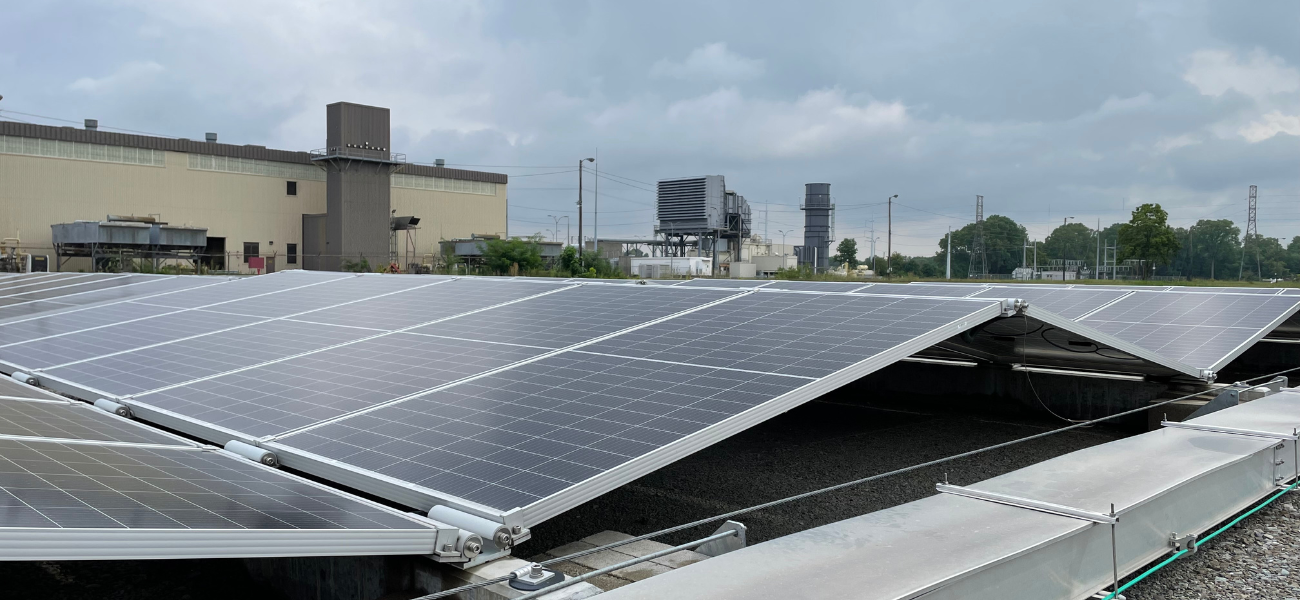
A row of solar panels sits outside AES Indiana's Harding Street power plant in Indianapolis. (Credit: Ryan Martin)
- Indiana stands to be particularly impacted by new greenhouse gas rules proposed by the Biden administration
- Indiana government leaders are concerned about potentially losing fossil fuel-fired power plants, which still provide most of the state’s energy
- Environmental advocates celebrate how the rules would help Indiana, which is one of the most-polluted states in the country
Indiana is probably the type of state that the Environmental Protection Agency had in mind when it proposed a new set of rules that target fossil fuel-fired power plants.
Not only is the state still reliant on fossil fuels for most electricity — more than two-thirds is generated by coal (47%) and gas (29%), data show — Indiana has some of the worst air quality and is one of the most polluted states in the country. The primary focus of the new EPA rules, though, is an attempt to significantly reduce the amount of carbon dioxide released by those plants. Fossil fuel-fired power plants are responsible for about a quarter of all greenhouse gas emissions, according to the EPA, and for about a third of the nation’s carbon dioxide emissions that are heating the planet.
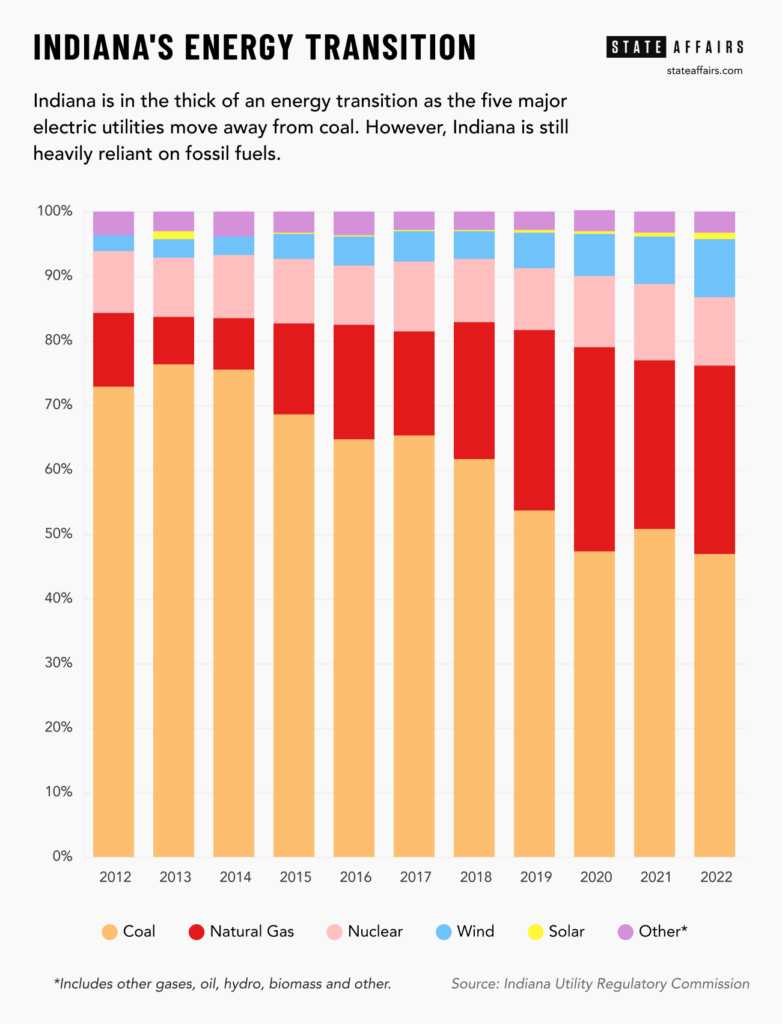
Yet while Indiana has been slow to adopt renewable energy sources, the pace of the state’s transition away from fossil fuels has been picking up steam in recent years.
But not fast enough for the EPA.
President Joe Biden’s aggressive climate agenda would require states like Indiana to hasten their energy transitions considerably. The draft power plant rules, released in May, would broadly require utility companies to cut their dependence on coal and gas, and to adopt emerging technologies that would enable the use of carbon storage and hydrogen.
Now Indiana government leaders and electric utility companies are raising concerns. They say the plans would force Indiana power plants to retire early, which could substantially increase the cost of electricity for Hoosiers while risking the reliability of the electric grid. And they say the technology cited by the EPA is not ready for widespread adoption.
“For carbon capture, while this is a technology that the state is invested in, it is not yet at the scale needed to accommodate all the utilities in the state,” Brian C. Rockensuess, commissioner of the Indiana Department of Environmental Management, told lawmakers during a committee meeting this month.
Environmental advocates, however, are characterizing the concerns as overblown. They point to two federal bills — the Inflation Reduction Act and the Bipartisan Infrastructure Law — that contain grants and incentives for power plants to transition away from coal and gas. And they say the power industry always raises concerns about any new regulations but always finds a way to comply.
“They are like the boy who cried wolf,” said David Doniger, a former EPA official and current senior strategic director at the nonprofit Natural Resources Defense Council. “If you look at the track record, they say this every time and then, if the regulations are in fact adopted, the compliance goes smoothly.”
Indiana agency head raises concerns
Rockensuess voiced his concerns about the new EPA rules to Indiana lawmakers during an Interim Study Committee on Energy, Utilities, and Telecommunications meeting this month.
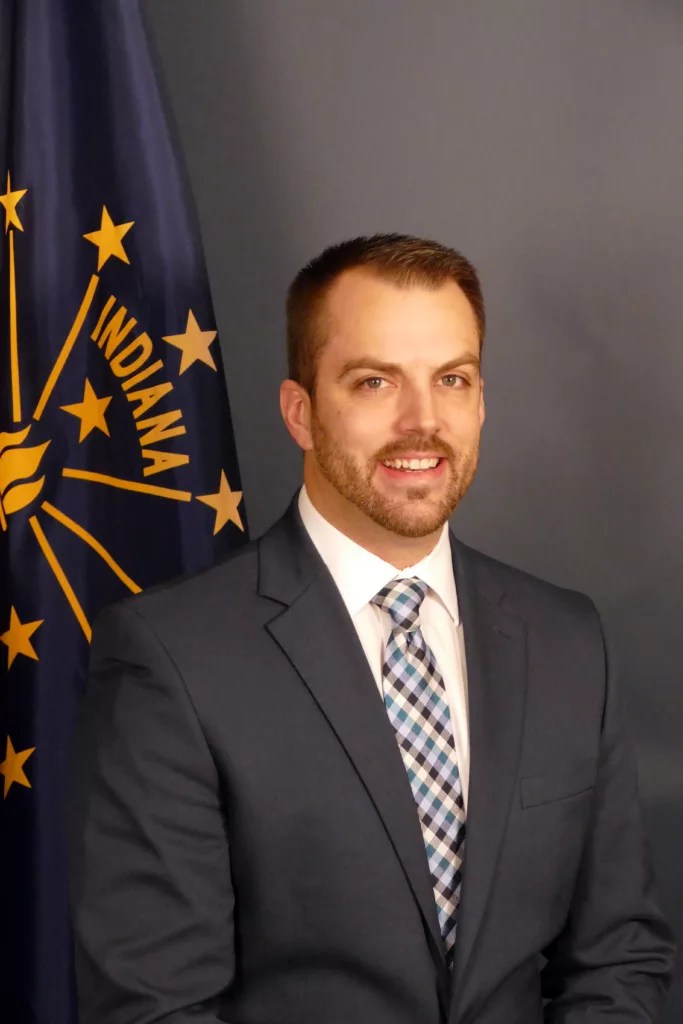
He didn’t dive into the pros and cons of the environmental impacts; rather, he focused on the difficulty for policymakers and regulators in Indiana who will be tasked with enforcing the final rules adopted by the federal government.
Among the difficulties, he said, are requirements for some power plants to use hydrogen to generate electricity or rely on carbon capture and storage to reduce emissions. Both technologies, he said, are not ready for wide use, yet the federal government would require Indiana to explain how the state would implement the new federal rules within 24 months.
“Bottom line is they are asking for a lot in too short of a time,” he said. "Indiana and other states are being set up to run afoul of that timeframe from the start."
Those concerns were echoed in a joint letter sent to the EPA by his department, the Indiana Utility Regulatory Commission and the Indiana Office of Utility Consumer Counselor.
The study committee also featured an out-of-state speaker who shared fiery testimony in opposition to the EPA proposal. By the end of the presentation, Rep. Matt Pierce, D-Bloomington, questioned whether the Republican leaders considered inviting anyone with a different viewpoint.
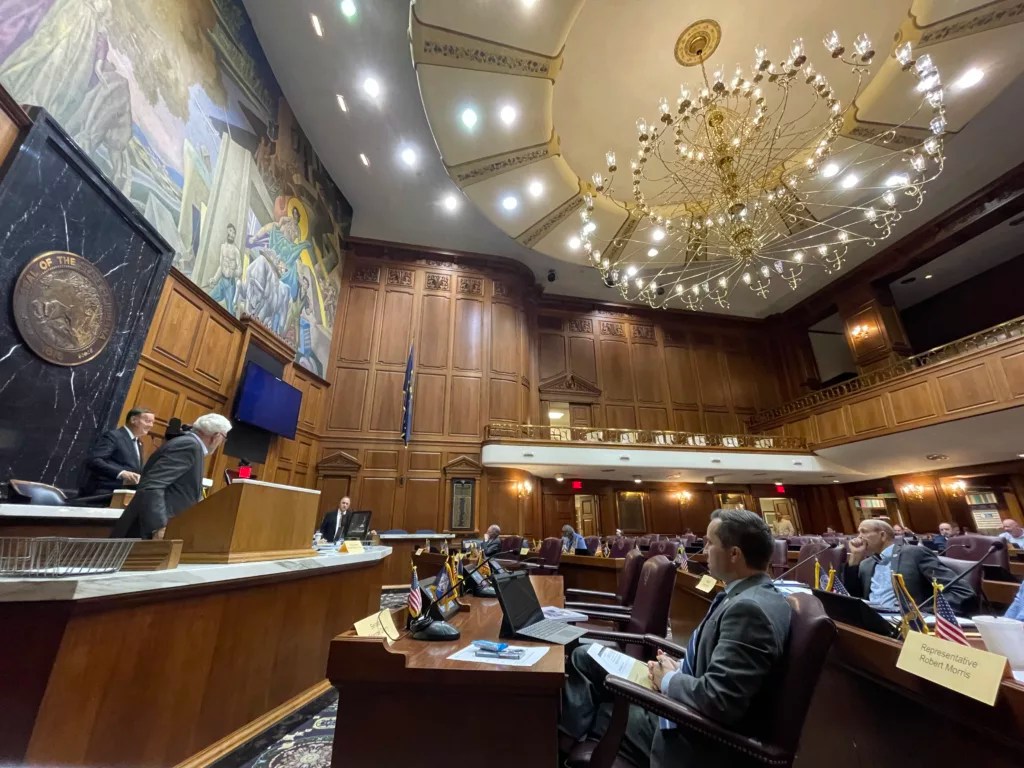
"I was just kind of curious as to whether the chairman attempted to invite testimony from anyone in support of the rules, such as the Clean Air Task Force or the Natural Resources Defense Council, people along those lines?” Piece asked.
Committee chair Sen. Eric Koch, R-Bedford, said that such viewpoints were already well-known because of the EPA’s plans, but he would consider Pierce’s request if lawmakers take up legislation on the matter when the legislative session begins in January.
Koch, who also leads the Senate utilities committee, later confirmed to State Affairs that he was unsure what actions the Indiana General Assembly might take in response to the federal rule, but he does not plan to file legislation this year.
The chair for the House utilities committee — Rep. Ed Soliday, R-Valparaiso — told State Affairs he did not yet know if he would file anything.
Environmental advocates push back
While they were not invited to speak at the public meeting, many environmental advocates in Indiana are supportive of the president’s efforts to curb carbon emissions.
“Probably what you didn’t hear in the testimony at the Statehouse was the cost of mitigating and addressing issues related to climate change. And you probably didn’t hear the effects of air pollution and how that contributes to asthma and other diseases,” said Sam Carpenter, executive director of the nonprofit Hoosier Environmental Council. “In the big picture, all those things need to be considered.”
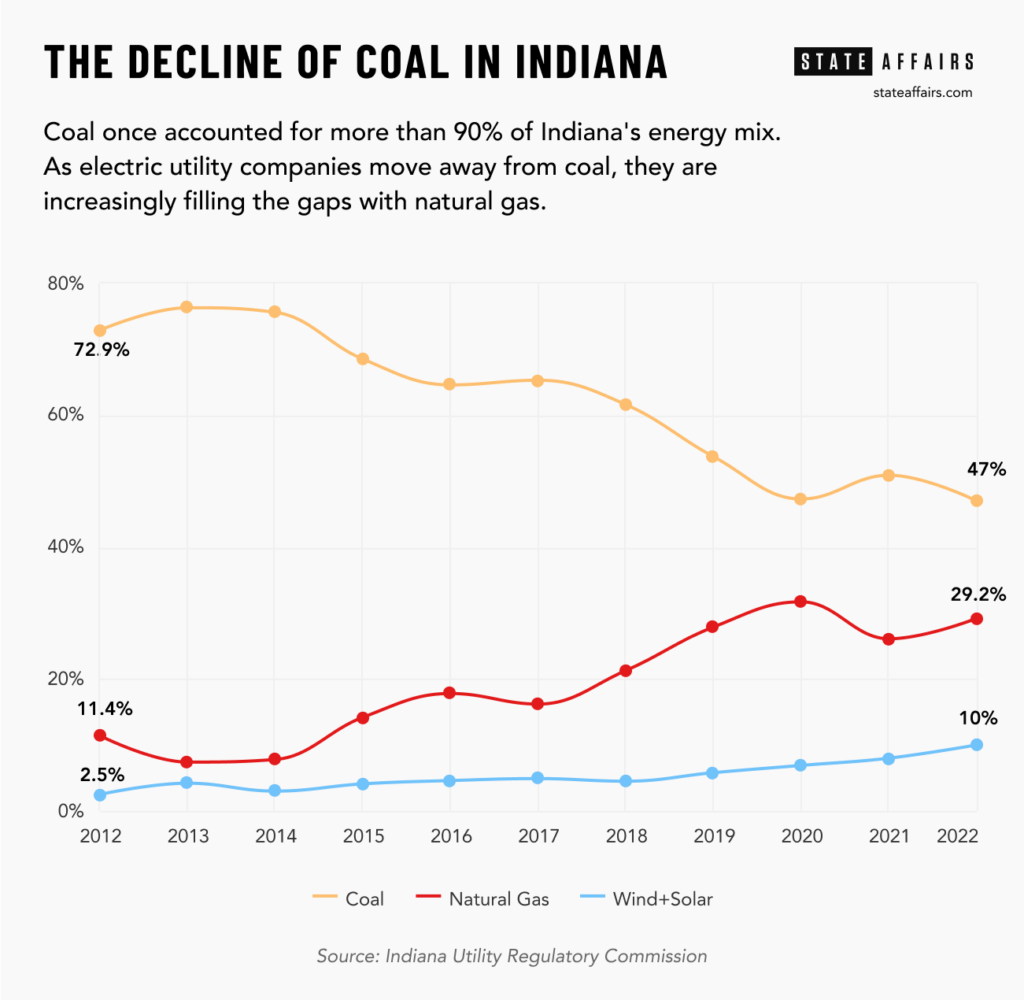
The Biden administration estimates up to $85 billion in environmental and public health benefits over the next 20 years.
Indiana once relied almost exclusively on coal for electricity. And while the state continues to be a top-five consumer of coal for electricity, the major utility companies have started shifting away from coal in recent years. They've largely replaced that fuel source, though, not with renewables but with natural gas. That’s because gas is relatively affordable, and it easily enables utility companies to both meet the daily electricity demands but also rapidly ramp up production during cold snaps and heat waves.
Some utilities are seeking state approval to build new gas plants even now. Indiana customers will be on the hook for whatever is constructed now — such as a gas plant — even if those plants are rarely used or even shut down because of federal regulations. And then Hoosiers will also have to pay for whatever the utility companies build next.
“This continued investment into fossil fuels is going to be a stranded investment,” Carpenter said. “Down the road that’s not going to be paying off. That’s just a bad path to take.”
Future battles
If enacted, the new EPA rules are sure to draw litigation from Republican officials.
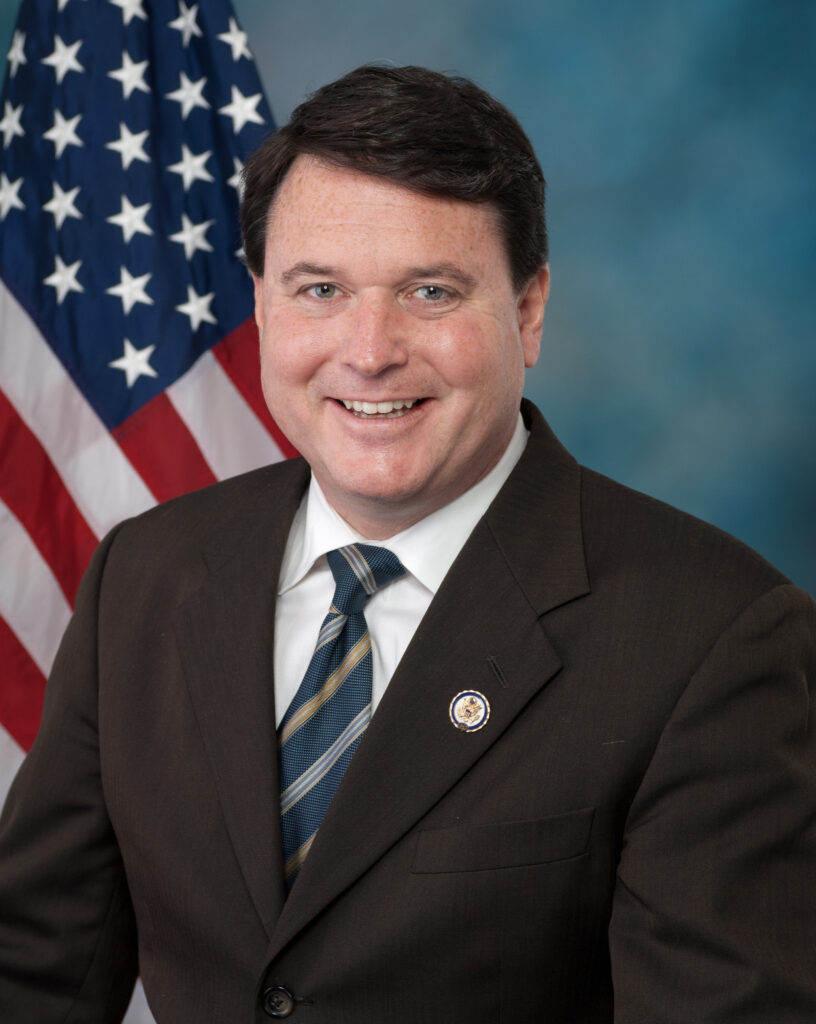
Attorney General Todd Rokita has already promised Indiana's involvement: “Fortunately, the courts will almost certainly strike down these new EPA mandates — and on behalf of Hoosiers, I’ll do everything in my power to ensure that happens,” Rokita said in a statement about the proposed rules.
His comments align with those made by Indiana’s major utility companies. They accuse the EPA of overstepping — arguments that were at the center of a U.S. Supreme Court decision in 2021 that said the EPA lacked the authority under the Clean Air Act to regulate carbon emissions.
Others aren't as confident as Rokita and utility companies.
Rockensuess, the state environmental management department commissioner, noted in his testimony that the EPA does have the authority because of new language contained in the Inflation Reduction Act, which Congress passed after the Supreme Court decision.
"It clarified and granted them the authority to regulate greenhouse gasses," Rockensuess told lawmakers.
Rockensuess said he expected to see the final EPA rule by next May.
Check out our summary on TikTok.
Contact Ryan Martin on X, Facebook, Instagram, LinkedIn, or at [email protected].
Facebook @stateaffairsin
Instagram @stateaffairsin
LinkedIn @stateaffairs
Header image: A row of solar panels sits outside AES Indiana's Harding Street power plant. (Credit: Ryan Martin)
Read this story for free.
Create AccountRead this story for free
By submitting your information, you agree to the Terms of Service and acknowledge our Privacy Policy.
How McCormick, Braun view abortion, taxes and other key issues
A Democrat-turned-Republican and Republican-turned-Democrat will soon face off in the race to become Indiana’s next governor.
Sen. Mike Braun, who voted as a Democrat prior to 2012, captured the Republican nomination in Tuesday’s primary. Jennifer McCormick, formerly a Republican Superintendent of Public Instruction, will represent the Democrats.
Voters will decide the state’s next chief executive in November.
A State Affairs analysis of the candidates’ campaign platforms and public statements found key differences — and a few similarities — in their planned approaches to a variety of issues impacting Hoosier voters.
Here is how they match up.
Abortion
Braun: As a senator, Braun has long supported abortion restrictions.
In 2020, he called for the Supreme Court to re-examine Roe v. Wade.
In 2023, he proposed federal legislation that would have required parental notification before any unemancipated minor could seek an abortion. He said at the time: “Hoosiers put their trust in me to stand up for the unborn, and that’s what I’ve been proud to do every day in the Senate.”
He has since signaled support for the state’s abortion ban. His platform reads: “State lawmakers must work to ensure the gains we have made to protect life are secured and strengthened.”
McCormick: In a Tuesday interview with State Affairs, McCormick said her candidacy represented a referendum on reproductive rights.
“I’m going to fight to restore those rights under any authority I can, working in a bipartisan fashion, using our committees, board and our agencies. I also know, too, what everybody’s fear is: that they’re [Republicans] not going to restore those rights and will take [restrictions] further.”
From her platform: “Indiana’s Republican-led extreme abortion ban has taken away the right of women to make deeply personal decisions regarding their own health care.”
Marijuana
Braun: At a March 26 Republican primary debate, Braun suggested an openness to legalizing medicinal marijuana.
“It’s gonna hit all of us. I’m gonna listen to law enforcement — they have to put up with the brunt of it,” he said. “Medical marijuana is where I think the case is best made that maybe something needs to change. But I’ll take my cue from law enforcement there as well. … I hear a lot of input where [medical marijuana is] helpful, and I think that you need to listen and see what makes sense.”
McCormick: The Democrat’s platform also addresses medical marijuana legalization, while speculating on possible recreational use.
“We will fight for the legalization of medical marijuana as a source of state revenue established on a well-regulated marketplace and monitored by a Cannabis Task Force in order to study the issues, opportunities and potential obstructions associated with recreational marijuana legalization.”
McCormick said she would also support expunging low-level marijuana-related convictions.
Taxes
Braun: At a March 19 National Federation of Independent Business forum, Braun said the state’s property tax system “went out of whack because it couldn’t respond to inflation like we’ve never seen before.”
“The way you finance any lower taxes would be to bank on the government being run more efficiently,” he said.
His platform also calls for government spending cuts to finance lower taxes: “Reducing the size of government is the key to cutting taxes, and Mike Braun will work through every state agency to find ways to save money while delivering high-quality services to taxpayers.”
McCormick: McCormick also spoke about taxes at the March 19 forum.
“I agree with a revamp of our taxing system,” she said. “But also it’s about not just how we’re getting our revenue, it’s about our expenditures. Yes, we need to fix our gas tax. Yes, we need to look at the income tax. But here’s the thing: There are hidden taxes we’re not having a conversation about.”
Her platform also references the possibility of combining state agencies as a way to save money.
Education
Braun: In his platform, Braun supports broadening school choice and parental rights.
“As a former school board member, Mike Braun knows parents are the primary stakeholders in their children’s education and every family, regardless of income or zip code, should be able to enroll in a school of their choice and pursue a curriculum that prepares them for a career, college or the military,” the platform reads.
Braun also pledged to ensure critical race theory and discussions about gender are banned in public schools.
McCormick: Education is one of McCormick’s primary issues, according to her platform.
She calls for the elimination of statewide testing, increased early childhood reading and child care options and a minimum base salary of $60,000 for all K-12 teachers.
McCormick also addresses the state’s school choice movement.
“We will call for a pause in the expansion of school privatization efforts while requiring fiscal and academic accountability and transparency for all of Indiana schools that receive public tax dollars,” her platform reads.
U.S.-Mexico border
Braun: Braun’s television ads have touched on border security, and his platform calls for increased focus on the area.
“Joe Biden and the left have created a humanitarian and national security crisis on our southern border,” the platform reads. “As governor, Mike will continue to support and enact the America First policies that were working. Otherwise, every town will become a border town.”
McCormick: McCormick’s border-related plans are more focused on facilitating legal immigration.
“We will work with local, state and federal officials in supporting an immigrant system that creates a safe, timely, orderly and humane pathway for those seeking legal immigration while keeping our communities and those responsible for border security safe,” her platform reads.
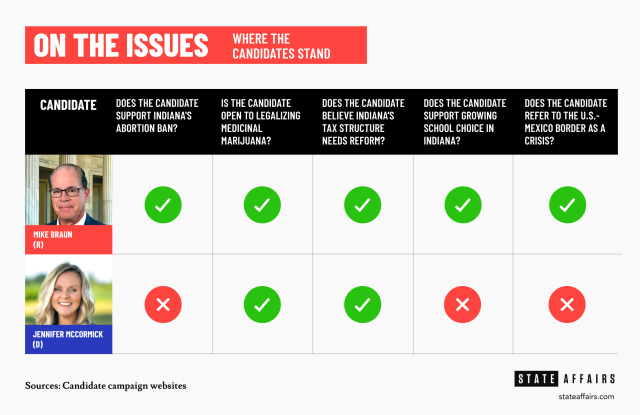
Contact Rory Appleton on X at @roryehappleton or email him at [email protected].
Spartz, Shreve, Stutzman win Republican congressional primaries
A central Indiana congresswoman successfully fought off eight primary challengers, while crowded races for three other Republican-leaning congressional districts began to clear in Tuesday’s primary election. And in northeastern Indiana, a former congressman held on in a tight race as he seeks to return to Congress. All of the state’s nine U.S. House of Representatives …
Mike Braun wins the Indiana Republican nomination for governor
U.S. Sen. Mike Braun was declared the winner of the Republican gubernatorial nomination shortly after polls in Indiana’s Central Time Zone closed. With 98% of votes counted as of Wednesday morning, Braun had 39.6%, followed by Lt. Gov. Suzanne Crouch with 21.8%, Brad Chambers with 17.5%, Eric Doden with 11.9 %, Jamie Reitenour with 4.8% …
Here’s how to vote in Indiana’s primary election
Thousands of Hoosier voters will head to the polls Tuesday, May 7, for Indiana’s primary election. This year’s ballot includes a competitive contest for governor, as well as dozens of state and federal legislative races and a few school referenda. The primary will decide which candidates will represent their respective parties in the Nov. 5 …

